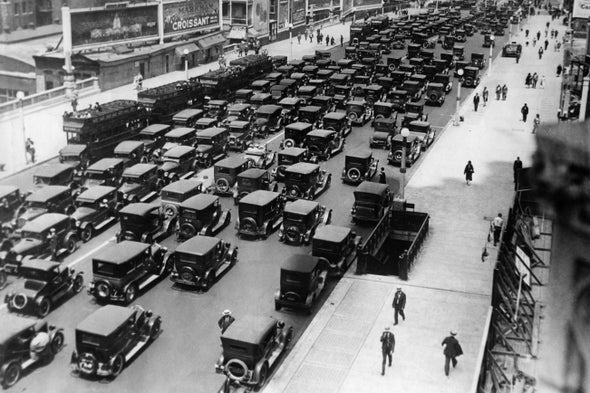
The climate crisis has created an acute awareness of history: human decisions made in the past are clearly having a large and critical impact on the present, and what is done in the present can have a large and critical impact on our future. It is becoming equally clear that our past is difficult to shake off as we are so far mostly continuing along the same behavioral paths as before. Combating climate change, however, requires “rapid, far-reaching and unprecedented changes in all aspects of society.”
Being economic historians, our first impulse in the face of climate change is to recognize that current actions can be informed by analyses of similar large-scale transitions in history. Similarly, understanding what got us in this predicament is likely to give us important clues to what is needed to take us out of it.
Tracing the origins of the fossil fuel economy and the rise of the gasoline-based automotive industry leads to a puzzle. It is not widely known that electric, and even steam, cars were already serious contenders for market dominance in the beginning of the 20th century. This not least in the U.S. where in 1900 gasoline-powered cars accounted for only 20 percent of automobiles produced, while the rest were a split between electric and steam engines.
In a study recently published in Nature Energy we aimed to understand what gave rise to the gasoline car rather than the electric. The conventional take is that electric vehicles were more expensive and technically inferior. Aided by data on more than 36,000 U.S. automobile passenger car models manufactured during 1895–1942, we found that electric vehicles were more expensive, but not in relation to performance. Early electrics were light and small by today’s standards, which allowed early electrics to boast an average range of about 90 miles per charge in the 1910s.
Why then were gasoline cars favored? Our analysis brings us to the key importance of infrastructure, that came too late for electrics. We find that the limited access to electricity constrained electric vehicle car producers to urban areas. Car manufacturers chose technology based on the conditions that prevailed at the beginning of the 20th century. Although the electricity network expanded in coming decades, this did not cause a shift in propulsion. Already by the 1910s, the industry had essentially become locked into a carbon-intensive technology choice.
While the electrification of industry picked up early on, still by the early 1930s most households had no or substandard electricity access. Part of the reason was that the household market was not profitable for private utilities. There was no broad political commitment to universal service until Roosevelt's New Deal and its Rural Electrification Act, providing federal loans for the installation of electricity. The New Deal, however, came decades too late for the producers of electric vehicles.
What if electricity had been available at a broader scale? To bring out the oomph of our models, we imagine a counterfactual world where electricity grids had diffused at a similar pace but 15 or 20 years earlier. The simulations suggest this would have sufficed to tip the balance in favor of electric vehicles, especially in metropolitan areas. The most plausible counterfactual scenario is a dual transportation system—also suggested by technology historian David Kirsch—with electric vehicles servicing metropolitan areas, and gasoline cars having a stronger position in touring and the countryside.
The fossil fuel–based transportation system is at the heart of the current climate crisis. It is no exaggeration that human impact on the environment would have looked wildly different if automobile technologies had developed towards a dual transportation system or even a purely electric one. We estimate that the savings in CO2 emissions (and running costs) would have been sizeable, shaving off up to 75 percent of CO2 emissions per mile travelled from personal transport in 1940.
Are we getting it right this time? The case of modern electric vehicles is no doubt a case in point. The supply of charging stations is still a bottleneck, and so is infrastructure required for complementary charging technologies like electric roads. Electric vehicles as of 2021 still account only for a negligible fraction of the vehicle stock, in many cases augmenting the vehicle stock rather than substituting the gasoline models. Every new gasoline car being sold will take 20 years to turn over. This is a worrying development, especially in the light of reports showing that just 30 percent of cars will be electric by 2050 under current policies. It will therefore take years before the transition to electric vehicles will make a dent to the rising levels of greenhouse gas emissions from the transport sector. On the bright side, the calls for “Green New Deals,” with various levels of ambition, have stressed the importance of infrastructure and we have recently seen policy initiatives going in this direction, like the EU `Fit for 55’ package adopted this year, or US President Joe Biden’s much discussed but so far not realized infrastructure bill. Still, many national roadmaps for future emission reductions rely on hockey-stick trajectories, usually failing to address the importance of complementary infrastructures or system integration.
Our analysis shows that the success or failure to provide complementary infrastructure can speed up or slow down—or even put a halt to—important large-scale transitions. Without (infra-)structures in place to break carbon lock-in, instruments like carbon taxes or carbon credits may, while efficient in theory, be woefully ineffective in practice. Therefore, we argue that complementary infrastructures and system solutions need to receive as much attention as the development of technology. A focus on infrastructure can shift perspectives on the role of policy from fixing market failures, to creating markets, as well as creating long-run stability and a clear sense of direction for producers and users.
